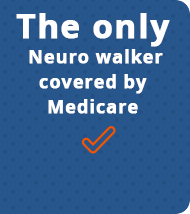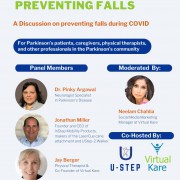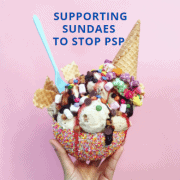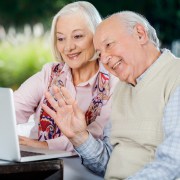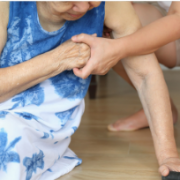Avoid the Risks, Avoid the Falls
In our January blog post, we discussed the scary prospects of falling, its high recurrence and potential complications. Once above the age of 65, falling is often the first descent on a slippery slope towards failing health. In such cases, the best remedy is actually prevention. As such, we present to you part two of our falling posts, in which we take a deep dive into the risks of falling, and what can be done to prevent them. Through this education, you and your loved ones can be alert to the risk factors for falling, and how to avoid them. Be aware– it could mean life or death.
Movement, Strength, and Balance
Among several of the leading personal risk factors, several related to activity and daily movement stand out. Maintaining an active lifestyle can be life-saving.
Risk factor #1: Muscle weakness, particularly in the legs.
Weak muscles in older people can greatly increase the risk of falling compared to those who maintain muscle strength and tone. Maintaining as much activity and strength building in the legs as possible can not only decrease potential falls, but can have positive effects on endurance and flexibility, which can also reduce risk.
Risk factor #2: How one walks.
Did you know that how you walk can determine your risk factor for falling? When walking properly and with a steady gait, older adults lower their risk. Similarly, poor balance and difficulty walking can raise the stakes. While difficulty with walking properly can be caused by a neurological cause or certain kinds of arthritis, it can also be caused by other medical conditions and treatment, like which medication the individual can take. Noticing a change in how you walk should be reported to a medical professional. another factor to difficulty walking can be simply a lack of exercise. Older adults who maintain a degree of exercise in their routine can benefit and be more stable.
Risk factor #3: Blood pressure drops when getting up from a lying down or sitting position.
Postural hypotension, which causes a drop in blood pressure when getting up, occurs in many older adults. This in turn could lead to a potential fall shortly after rising. While the exact cause can vary, several issues can effect the severity and likelihood of experience this drop. Dehydration, or some medications may cause this. Scientists have also linked it to diabetes, Parkinson’s disease, infection, and other neurological conditions. Being aware and taking care, as well as being sure to stay hydrated and getting up slowly could help mitigate this risk. Always be sure to check your medications for side-effects so you can be mindful when beginning to stand.
Maintaining Movement
Although all three of these risk factors involve problems in and during movement, elderly people can struggle to maintain an active lifestyle. Though pushing through discomfort and fear and continue to move regularly is essential for preventing falling, it is easy to opt for easier options which discourage movement. Many elderly people, especially those with Parkinson’s Disease, opt quickly for scooter and other motorized choices. Yet it is not the only option. One U-Step user may have reduced her risk for falling significantly by making the choice to try our walker instead. Here is what her son told us.
Steven Klopfer’s mother was diagnosed with Parkinson’s Disease in January 2014. After using a traditional walker for two years and struggling, she was ready to give in an get a prescription for a motorized scooter. The doctors wanted her to be able to get around, but did not want her to lose her muscle tone and the benefits of continued walking. During a visit to their neurologist to get paperwork for a power scooter the doctor intervened.
Her son described the visit: “The doctor thought Mom would be able to use a U-Step walker. Mom first tried it at her doctor’s office and even though she could walk better, she still objected and wanted the scooter. That’s when the doctor told her that if she didn’t “move it she’d lose it”, meaning, “use your muscles or they will stop working for you.” Mom and I reached a deal–try the U-Step for 2-weeks, if she wasn’t able to walk better and safer, we would take the next step and get the scooter. That was three years ago. She’s still walking with her U-Step.”
Although Mrs. Klopfer could have given in to her fears, her choice to use the U-Step walker made sure she didn’t “lose it.” This fateful visit most likely saved her from increasing her risk of falling.
Other Risk Factors for Falling
Other preventative measures can allow individuals to reduce the risk of falling. Some of these risk factors include:
Risk factor #4: Vision problems.
Trouble with vision, a lack of good depth perception, or eye conditions like cataracts or glaucoma could lead to falling. Be careful of what glasses you wear- multi-focals when moving, or poor lighting in your home could potentially increase your risk. Don’t skip the light switch; maintaining proper lighting could be a game-changer for preventing a spill.
Risk factor #5: Disorientation or confusion.
While visiting friend or relatives can be relaxing and fun, waking up in an unfamiliar environment and getting up without waiting to orient and familiarize yourself with your surroundings can increase the danger. Taking the time to remember where you are can be a big factor in preventing falls. Asking for help in a new place is never a bad idea.
Risk factor #6: Side effects from medications and taking multiple medications at once.
Be careful to check your medications, and be aware of their effects! Some medications, while they are necessary for health, can come with baggage. Dizziness and confusion are common side effects to certain drugs. Even without a known side effect, studies have shown that taking four or more medications can cause falling. Knowing these risks and taking time to get from place to place may help prevention.
Though there are many risk factors for falling, being aware of these causes can help older adults make informed decisions to avoid and even potentially prevent falls. Maintaining activity and taking care among other steps, could save you or your loved ones in the future.
